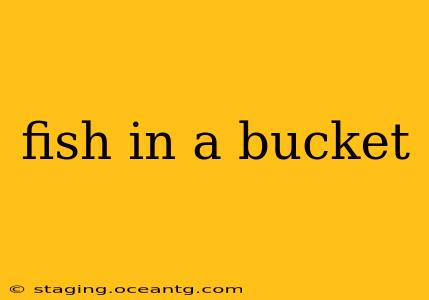Keeping Fish in a Bucket: A Comprehensive Guide
Keeping fish in a bucket might seem like a simple task, but it requires careful consideration to ensure the well-being of the aquatic creatures. This guide explores the essential aspects of temporary and, in limited cases, longer-term fish keeping in a bucket, addressing common concerns and offering practical advice. We'll delve into the crucial factors to consider before, during, and after housing fish in a bucket, aiming to provide a comprehensive resource for both novice and experienced fish keepers.
How long can fish live in a bucket?
This depends heavily on several factors: the species of fish, the size of the bucket, the water quality, and the frequency of water changes. Small, hardy fish might survive for a day or two in a well-oxygenated bucket with adequate water volume. Larger or more delicate species will require more frequent water changes and are unlikely to thrive for extended periods. It's crucial to remember that a bucket is not an ideal long-term habitat. Even with meticulous care, prolonged confinement in a bucket can lead to stress, disease, and ultimately, death. Aim for the shortest possible duration; a bucket should serve as temporary housing only.
What kind of fish can survive in a bucket?
Some hardy fish species are more tolerant of temporary confinement than others. Smaller, less demanding species like goldfish (though even these need adequate space and care) are more adaptable than larger, more sensitive fish. However, even hardy species will suffer if kept in a bucket for too long. Consider the species' natural habitat and oxygen requirements. Avoid fish known for requiring highly specific water parameters or larger tank volumes.
What size bucket do I need for fish?
The bucket size is critical. The more water, the better. There needs to be enough space for the fish to swim comfortably without feeling cramped. A general rule is to provide at least one gallon of water per inch of fish length (this is a minimum guideline and more space is always better). Larger buckets also help maintain better water quality over time.
How do I keep fish in a bucket alive?
Proper water conditions are paramount. Use clean, dechlorinated water. An aerator is essential to provide sufficient oxygen, particularly if the bucket is small or the fish are numerous or large. Regular water changes are necessary to remove waste products and maintain water quality. If you must keep fish in a bucket for more than a few hours, plan on changing a significant portion of the water at least twice a day. Avoid overcrowding the bucket – leaving ample space between fish reduces stress and improves water quality.
Can I use a food bucket to keep fish?
Food-grade buckets are generally acceptable for short-term fish storage, provided they have been thoroughly cleaned and rinsed before use. Ensure no food residue remains, as this can contaminate the water. However, buckets specifically designed for fish keeping are preferred as they are often more durable, provide better transparency for monitoring, and sometimes even include features like built-in filtration or oxygenation.
Is it cruel to keep fish in a bucket?
Keeping fish in a bucket for an extended period is undoubtedly stressful and potentially cruel. It compromises their well-being by restricting their movement, limiting access to essential nutrients, and exposing them to poor water quality. It is a viable option only for extremely brief periods, such as during transportation or temporary holding before transferring to a proper aquarium. Ethical fish keeping requires providing an appropriate habitat that meets the species' specific needs.
In conclusion, while a bucket can temporarily house fish, it is crucial to minimize the duration and prioritize the fish's welfare by ensuring adequate oxygenation, water quality, and sufficient space. A bucket should never be a permanent solution; it is only appropriate as a temporary measure. Responsible fish ownership necessitates providing a suitable environment that meets the specific needs of the chosen species.
